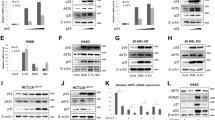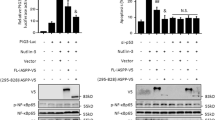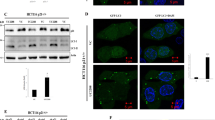Abstract
The insulin-like growth factor-1 (IGF-1) and its downstream effector Akt have been documented as survival factors in response to a variety of stress signals. In this study, we show that IGF-1 activates p21 protein expression in a p53-dependent manner. Inhibition of PI-3 kinase or ectopic expression of a dominant-negative Akt blocks the effect of IGF-1 on the upregulation of p21 expression. In addition, IGF-1 prevents the UV irradiation-mediated suppression of p21 and MDM2 expression. Furthermore, p21 is important for IGF-1-mediated cell survival upon UV irradiation. Taken together, these data indicate that IGF-1 may activate p21 in executing its survival function upon genotoxic insults.
This is a preview of subscription content, access via your institution
Access options
Subscribe to this journal
Receive 50 print issues and online access
$259.00 per year
only $5.18 per issue
Buy this article
- Purchase on Springer Link
- Instant access to full article PDF
Prices may be subject to local taxes which are calculated during checkout






Similar content being viewed by others
References
Asada M, Yamada T, Ichijo H, Delia D, Miyazono K, Fukumuro K and Mizutani S . (1999). EMBO J, 18, 1223–1234.
Ashcroft M, Ludwig RL, Woods DB, Copeland TD, Weber HO, MacRae EJ and Vousden KH . (2002). Oncogene, 21, 1955–1962.
Biggs III WH, Meisenhelder J, Hunter T, Cavenee WK and Arden KC . (1999). Proc Natl. Acad. Sci. USA, 96, 742l–7426.
Brugarolas J, Chandrasekaran C, Gordon JI, Beach D, Jacks T and Hannon GJ . (1995). Nature, 377, 552–557.
Brunet A, Bonni A, Zigmond MJ, Lin MZ, Juo P, Hu LS, Anderson MJ, Arden KC, Blenis J and Greenberg ME . (1999). Cell, 96, 857–868.
Buckbinder L, Talbott R, Velasco-Miguel S, Takenake I, Faha B, Seizinger BR and Kley N . (1995). Nature, 377, 646–649.
Bunz F, Hwang PM, Torrance C, Waldman T, Zhang Y, Dillehay L, Williams J, Lengauer C, Kinzler KW and Vogelstein B . (1999). J. Clin. Invest., 104, 263–269.
Cardone MH, Roy N, Stennicke HR, Salvesen GS, Franke TF, Stanbridge E, Frisch S and Reed JC . (1998). Science, 282, 1318–1321.
Carter CS, Ramsey MM and Sonntag WE . (2002). Trends Genet., 18, 295–301.
Datta SR, Brunet A and Greenberg ME . (1999). Genes Dev., 13, 2905–2927.
Datta SR, Dudek H, Tao X, Masters S, Fu H, Gotoh Y and Greenberg ME . (1997). Cell, 91, 231–241.
del Peso L, Gonzalez-Garcia M, Page C, Herrera R and Nunez G . (1997). Science, 278, 687–689.
Dudek H, Datta SR, Franke TF, Birnbaum MJ, Yao R, Cooper GM, Segal RA, Kaplan DR and Greenberg ME . (1997). Science, 275, 661–665.
Geier A, Beery R, Haimsohn M and Karasik A . (1995). Cancer Invest., 13, 480–486.
Gooch JL, Van Den Berg CL and Yee D . (1999). Breast Cancer Res. Treat., 56, 1–10.
Gorospe M, Cirielli C, Wang X, Seth P, Capogrossi MC and Holbrook NJ . (1997). Oncogene, 14, 929–935.
Gottlieb TM, Leal JF, Seger R, Taya Y and Oren M . (2002). Oncogene, 21, 1299–1303.
Grimberg A and Cohen P (2000). J. Cell Physiol., 183, 1–9.
Harrington EA, Bennett MR, Fanidi A and Evan GI . (1994). EMBO J., 13, 3286–3295.
Hermeking H, Lengauer C, Polyak K, He TC, Zhang L, Thiagalingam S, Kinzler KW and Vogelstein B . (1997). Mol. Cell, 1, 3–11.
Kamijo T, Weber JD, Zambetti G, Zindy F, Roussel MF and Sherr CJ . (1998). Proc. Natl. Acad. Sci. USA, 95, 8292–8297.
Kauffmann-Zeh A, Rodriguez-Viciana P, Ulrich E, Gilbert C, Coffer P, Downward J, Evan G . (1997). Nature, 385, 544–548.
Kennedy SG, Wagner AJ, Conzen SD, Jordan J, Bellacosa A, Tsichlis PN and Hay N . (1997). Genes Dev., 11, 701–713.
Kitamura T, Ogawa W, Sakaue H, Hino Y, Kuroda S, Takata M, Matsumoto M, Maeda T, Konishi H, Kikkawa U and Kasuga M . (1998). Mol. Cell. Biol., 18, 3708–3717.
Kops GJ, de Ruiter ND, De Vries-Smits AM, Powell DR, Bos JL and Burgering BM . (1999). Nature, 398, 630–634.
Kulik G, Klippel A and Weber MJ . (1997). Mol. Cell. Biol., 17, 1595–1606.
Lakin ND and Jackson SP . (1999). Oncogene, 18, 7644–7655.
Lawlor MA and Rotwein P . (2000a). J. Cell Biol., 151, 1131–1140.
Lawlor MA and Rotwein P . (2000b). Mol. Cell. Biol., 20, 8983–8995.
Li Y, Dowbenko D and Lasky LA . (2001). J. Biol. Chem., 276, 52.
Lu X, Burbidge SA, Griffin S and Smith HM . (1996). Oncogene, 13, 413–418.
Matsui T, Li L, del Monte F, Fukui Y, Franke TF, Hajjar RJ and Rosenzweig A . (1999). Circulation, 100, 2373–2379.
Mayo LD and Donner DB . (2001). Proc. Natl. Acad. Sci. USA, 98, 11598–11603.
McKay BC, Ljungman M and Rainbow AJ . (1998). Oncogene, 17, 545–555.
Meek DW . (1999). Oncogene, 18, 7666–7675.
Mitsuuchi Y, Johnson SW, Selvakumaran M, Williams SJ, Hamilton TC and Testa JR . (2000). Cancer Res., 60, 5390–5534.
Miyashita T and Reed JC . (1995). Cell, 80, 293–299.
Nakano K and Vousden KH . (2001). Mol. Cell., 7, 683–694.
Nghiem P, Park PK, Kim Y, Vaziri C and Schreiber SL . (2001). Proc. Natl. Acad. Sci. USA, 98, 9092–9027.
Oda K, Arakawa H, Tanaka T, Matsuda K, Tanikawa C, Mori T, Nishimori H, Tamai K, Tokino T, Nakamura Y and Taya Y . (2000b). Cell, 102, 849–862.
Oda E, Ohki R, Murasawa H, Nemoto J, Shibue T, Yamashita T, Tokino T, Taniguchi T and Tanaka N . (2000a). Science, 288, 1053–1058.
Okubo Y, Blakesley VA, Stannard B, Gutkind S and Le Roith D . (1998). J. Biol. Chem., 273, 25961–25966.
Ozes ON, Mayo LD, Gustin JA, Pfeffer SR, Pfeffer LM and Donner DB . (1999). Nature, 401, 82–85.
Polyak K, Waldman T, He TC, Kinzler KW and Vogelstein B . (1996). Genes Dev., 10, 1945–1952.
Polyak K, Xia Y, Zweier JL, Kinzler KW and Vogelstein B . (1997). Nature, 389, 300–305.
Pomerantz J, Schreiber-Agus N, Liegeois NJ, Silverman A, Alland L, Chin L, Potes J, Chen K, Orlow I, Lee HW, Cordon-Cardo C and DePinho RA . (1998). Cell, 713–723.
Romashkova JA and Makarov SS . (1999). Nature, 401, 86–90.
Rossig L, Badorff C, Holzmann Y, Zeiher AM and Dimmeler S . (2002). J. Biol. Chem., 4, 4.
Rossig L, Jadidi AS, Urbich C, Badorff C, Zeiher AM and Dimmeler S . (2001). Mol. Cell. Biol., 21, 5644–5657.
Sandhu MS, Dunger DB and Giovannucci EL . (2002). J. Natl. Cancer Inst., 94, 972–980.
Shaulian E, Schreiber M, Piu F, Beeche M, Wagner EF and Karin M . (2000). Cell, 103, 897–907.
Sherr CJ and Weber JD . (2000). Curr. Opin. Genet. Dev., 10, 94–99.
Shimoke K, Yamagishi S, Yamada M, Ikeuchi T and Hatanaka H . (1999). Brain Res. Dev. Brain Res., 112, 245–253.
Stewart CE and Rotwein P . (1996). Physiol. Rev., 76, 1005–1026.
Stott FJ, Bates S, James MC, McConnell BB, Starborg M, Brookes S, Palmero I, Ryan K, Hara E, Vousden KH and Peters G . (1998). EMBO J., 17, 5001–5014.
Vogelstein B, Lane D and Levine AJ . (2000). Nature, 408, 307–310.
Vousden KH (2002). Biochim. Biophys. Acta, 1602, 47–59.
Vousden KH and Lu X . (2002). Nat. Rev. Cancer, 2, 594–604.
Waldman T, Lengauer C, Kinzler KW and Vogelstein B . (1996). Nature, 381, 713–716.
Wang JA, Fan S, Yuan RQ, Ma YX, Meng Q, Goldberg ID and Rosen EM . (1999). Int. J. Radiat. Biol., 75, 301–316.
Woods DB and Vousden KH . (2001). Exp. Cell Res., 264, 56–66.
Wu L and Levine AJ . (1997). Mol. Med., 3, 441–451.
Xu SQ and El-Deiry WS . (2000). Biochem. Biophys. Res. Commun., 269, 179–190.
Zeng X, Keller D, Wu L and Lu H . (2000). Cancer Res., 60, 6184–6188.
Zhang Y, Xiong Y and Yarbrough WG . (1998). Cell, 92, 725–734.
Zhou BP, Liao Y, Xia W, Spohn B, Lee MH and Hung MC . (2001a). Nat. Cell Biol., 3, 245–252.
Zhou BP, Liao Y, Xia W, Zou Y, Spohn B and Hung MC . (2001b). Nat. Cell Biol., 3, 973–982.
Acknowledgements
We thank Drs Chuxia Deng and Tyler Jacks for wild-type MEF cells and p21−/− MEF cells, Dr Cyrus Vazari for p21-adenovirus, Drs Wataru Ogawa and Takashi Matsu for Akt- and AktDN adenoviruses, and Dr Jiandong Chen for MDM2 antibodies. This work is supported by NIH Grant R01CA79804 to Z-XX and DOD Grant DAMA17-97-1-7311 to ZXX.
Author information
Authors and Affiliations
Corresponding author
Rights and permissions
About this article
Cite this article
Murray, S., Zheng, H., Gu, L. et al. IGF-1 activates p21 to inhibit UV-induced cell death. Oncogene 22, 1703–1711 (2003). https://doi.org/10.1038/sj.onc.1206327
Received:
Revised:
Accepted:
Published:
Issue Date:
DOI: https://doi.org/10.1038/sj.onc.1206327
Keywords
This article is cited by
-
FGF1 inhibits p53-dependent apoptosis and cell cycle arrest via an intracrine pathway
Oncogene (2005)
-
The PI3K inhibitor LY294002 prevents p53 induction by DNA damage and attenuates chemotherapy-induced apoptosis
Cell Death & Differentiation (2005)
-
Down-regulation of p21 contributes to apoptosis induced by HPV E6 in human mammary epithelial cells
Apoptosis (2005)



